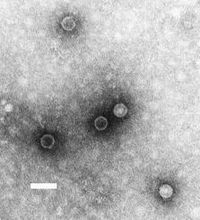
Photo from wikipedia
Poliovirus (PV) is the causative agent of poliomyelitis and is a target of the global eradication programs of the World Health Organization (WHO). After eradication of type 2 and 3… Click to show full abstract
Poliovirus (PV) is the causative agent of poliomyelitis and is a target of the global eradication programs of the World Health Organization (WHO). After eradication of type 2 and 3 wild-type PVs, vaccine-derived PV remains a substantial threat against the eradication as well as type 1 wild-type PV. Antivirals could serve as an effective means to suppress the outbreak; however, no anti-PV drugs have been approved at present. Here, we screened for effective anti-PV compounds in a library of edible plant extracts (a total of 6032 extracts). We found anti-PV activity in the extracts of seven different plant species. We isolated chrysophanol and vanicoside B (VCB) as the identities of the anti-PV activities of the extracts of Rheum rhaponticum and Fallopia sachalinensis, respectively. VCB targeted the host PI4KB/OSBP pathway for its anti-PV activity (EC50 = 9.2 μM) with an inhibitory effect on in vitro PI4KB activity (IC50 = 5.0 μM). This work offers new insights into the anti-PV activity in edible plants that may serve as potent antivirals for PV infection.
Journal Title: Viruses
Year Published: 2023
Link to full text (if available)
Share on Social Media: Sign Up to like & get
recommendations!